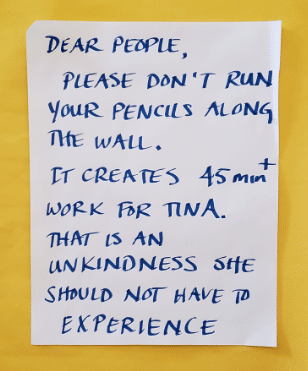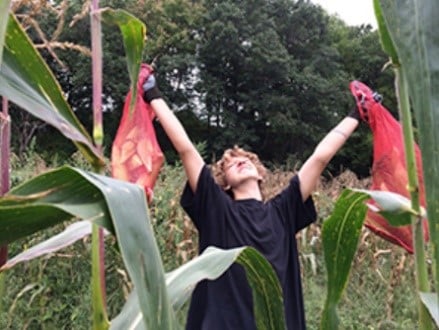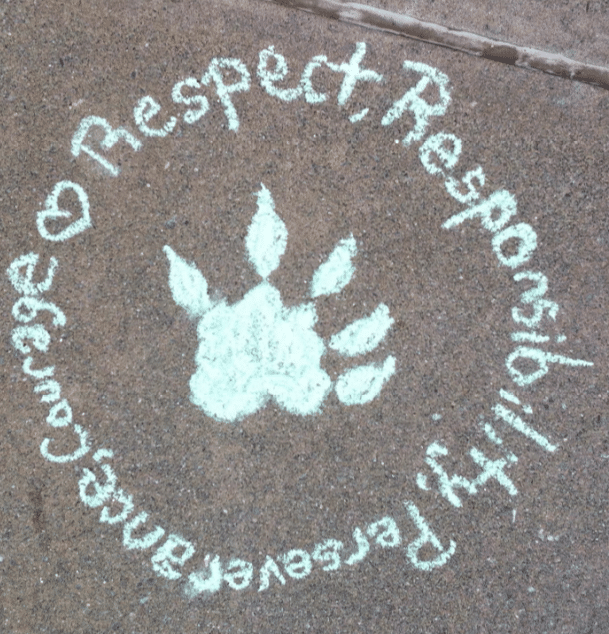Building a Powerful School Culture at Four Rivers
CompetencyWorks Blog
This is the first post in a series about Four Rivers Charter Public School in Greenfield, Massachusetts. Links to the other posts can be found at the end of this article.
Walking into the high school building recently at Four Rivers Charter Public School, an EL Education school where I used to teach, the first thing I saw was this sign:
 The sign epitomized the thoughtfulness, caring, and powerful teaching around school culture and social-emotional learning that run deep at Four Rivers. It helped students understand the impact of actions that they might not have considered. Writing “Tina” rather than “the custodian” highlighted that everyone is an important member of the school community. The sign was visually appealing, consistent with the school’s strong culture of quality and aesthetics. Notably, it hadn’t been torn or defaced. The wording was polite, not authoritarian, surely a more productive approach for encouraging student reflection and ownership.
The sign epitomized the thoughtfulness, caring, and powerful teaching around school culture and social-emotional learning that run deep at Four Rivers. It helped students understand the impact of actions that they might not have considered. Writing “Tina” rather than “the custodian” highlighted that everyone is an important member of the school community. The sign was visually appealing, consistent with the school’s strong culture of quality and aesthetics. Notably, it hadn’t been torn or defaced. The wording was polite, not authoritarian, surely a more productive approach for encouraging student reflection and ownership.
Four Rivers was founded in 2003 as an Expeditionary Learning (now called EL Education) school, a national model that strongly promotes competency-based practices. Located in Greenfield, Massachusetts, in the state’s rural northwestern corner, the school has 220 students in grades 7–12, drawn from Greenfield and many surrounding towns.
One of EL Education’s five core practices is “school culture and character,” a practice that Four Rivers focuses on intensively. Promoting a school culture of growth, empowerment, safety, and belonging is also essential for shifting to high-quality competency-based systems. The Four Rivers Student and Family Handbook says, “School culture is shaped by the accumulation of thousands of day-to-day interactions. How students are with each other, how teachers are with students, how students are with teachers, and much more all contribute to creating culture.” Four Rivers has many strategies to build school culture and character; two of them—community meetings and restorative circles—are described in this article.
Community Meeting
 The first event on the day I visited was the weekly community meeting. I attended the meeting for 11th and 12th graders, with about 30 students and eight staff members sitting in a circle. Each part of the 40-minute meeting both reflected and contributed to the school’s positive culture.
The first event on the day I visited was the weekly community meeting. I attended the meeting for 11th and 12th graders, with about 30 students and eight staff members sitting in a circle. Each part of the 40-minute meeting both reflected and contributed to the school’s positive culture.
Announcements – The head of guidance announced each students’ most recent college acceptances. Then a student announced her “moon-a-palooza” gathering, inviting everyone to her house to watch stars on an upcoming evening. Students clapped for each other after every announcement.
Questions and Concerns – A staff member reminded students that headphones were only permitted at particular times during the school day. She commented that there are times “when we want you fully engaged with the community, which makes us more inclusive and better,” and that there are times when wearing headphones works against that goal and the school’s behavior norms.
Building strong school cultures requires frequent, patient reminders of school norms, and the staff’s devotion to upholding them. This is something that the Four Rivers staff has worked on explicitly as a group. Even the frequently invoked term “school norms,” rather than “school rules,” promotes a sense of collective ownership and an appeal to everyone to be reasonable—a concept that resonates with many teenagers and that, over time, can build a virtuous circle of positive behavior.
Appreciations and Amends – One student offered amends to a teacher and classmates, saying “I’m really sorry for being disruptive in your class. Thank you for not flipping out on me. I’m trying to improve.” (Clearly students don’t offer amends every time they’re disruptive, but this part of the meeting offers students positive examples of how to make amends, opportunities to practice doing it, and the experience of how rewarding a strategy it can be.) A teacher thanked students for their support during a Model United Nations activity the day before, saying “It was my first time teaching that, and I appreciate your willingness to try to figure it out with me.” Again, this was terrific modeling, helping students understand that teachers are learners too, and how important students’ support and cooperation can be for improving the quality of an activity.
 Polaris Awards – Four Rivers bases their school culture on six Character Virtues: responsibility, respect, courage, compassion, perseverance, and integrity. They try to “catch students being good” each week and recognize them at Community Meeting with a Polaris Award, which includes a description of their positive actions and a certificate with their name and the character virtue(s) they have exemplified. At the meeting I attended, a student was recognized for taking on substantial responsibility during a recent school activity, and also for being compassionate on an ongoing basis. Providing fitting evidence of these virtues, earlier in the week she had arranged for another student to receive a Polaris Award, and she had it in her hand to present right after receiving her own.
Polaris Awards – Four Rivers bases their school culture on six Character Virtues: responsibility, respect, courage, compassion, perseverance, and integrity. They try to “catch students being good” each week and recognize them at Community Meeting with a Polaris Award, which includes a description of their positive actions and a certificate with their name and the character virtue(s) they have exemplified. At the meeting I attended, a student was recognized for taking on substantial responsibility during a recent school activity, and also for being compassionate on an ongoing basis. Providing fitting evidence of these virtues, earlier in the week she had arranged for another student to receive a Polaris Award, and she had it in her hand to present right after receiving her own.
Meeting Activity – Each community meeting ends with a longer activity. The assistant principal asked students how high their stress level had been recently, describing a few different levels and asking for a show of hands. The question was an introduction to a TED Talk entitled “How To Make Stress Your Friend.” It was based on a study that found that people who experienced high stress in the past year had a 43% increased risk of dying, but only if they also believed that stress was harmful for their health. The presenter then explained the psychology and biology behind these findings, in highly engaging TED-talk style, including the possible benefits of certain types of stress. This part of the community meeting was yet another powerful strategy for building social-emotional learning.
The meeting ended with a very brief video that one of the “crews” (advisories) had made—it was just plain silly, included a rapping cameo from the assistant principal, and there was lots of laughter and eye-rolling. Having fun together contributes to a strong school culture too, and promoting joy in learning is explicitly advocated by EL Education.
The term “crew” comes from EL Education’s motto—“we are crew, not passengers,” which they describe as “a spirit, a way of being. To be ‘crew’ means to pitch in to help each other, to step up and take responsibility for everyone’s well-being around you.” EL Education has made many of their powerful educational resources available to help other schools create more active, student-directed learning practices.
Restorative Circles
One teacher pointed out that the community meeting I attended was run by mature students at the end of 11th and 12th grade, who had been influenced by Four Rivers culture for several years, and that getting there had taken time. At turbulent times, one strategy Four Rivers has used is restorative circles. Students, staff, or both sit in a circle with a “talking piece” that is passed around the circle. Whoever holds the talking piece can speak without being interrupted.
Two restorative circles were held at a time when the behavior of many 11th graders was particularly problematic. Teachers described what they were noticing and asked students and staff how they saw it and what they thought the solutions were. Some students expressed frustration with their classmates, and some expressed frustration with themselves for misbehaving. It was not a magic bullet, and more interventions were needed, but it was helpful for raising awareness, starting some joint problem-solving, and giving everyone an opportunity to be heard.
A restorative circle was also used at a staff meeting, when some staff members were upset that others were not enforcing school norms around issues such as student dress code, swearing, and use of cell phones. It helped everyone hear each other’s perspectives and realize the impact their behavior was having on their colleagues. It also upheld school norms of talking directly with the person you are having an issue with.
I am grateful to Four Rivers Principal Peter Garbus and Assistant Principal Susan Durkee for welcoming and arranging my visit, and to the many teachers and students who spoke with me, shared materials, and allowed me to observe. Many of them are former colleagues from when I taught at Four Rivers from 2006 to 2009.
Links to Other Posts in the Series
- These will be added as they become available.
See Also:
- Empowering Teachers as School Leaders at Four Rivers
- Active Learning through Expeditions and Internships at Four Rivers
- Character Section of the Four Rivers School Portfolio
- EL Education Core Practices
- Teaching Restorative Practices with Classroom Circles
Eliot Levine is the Aurora Institute’s Research Director and leads CompetencyWorks.